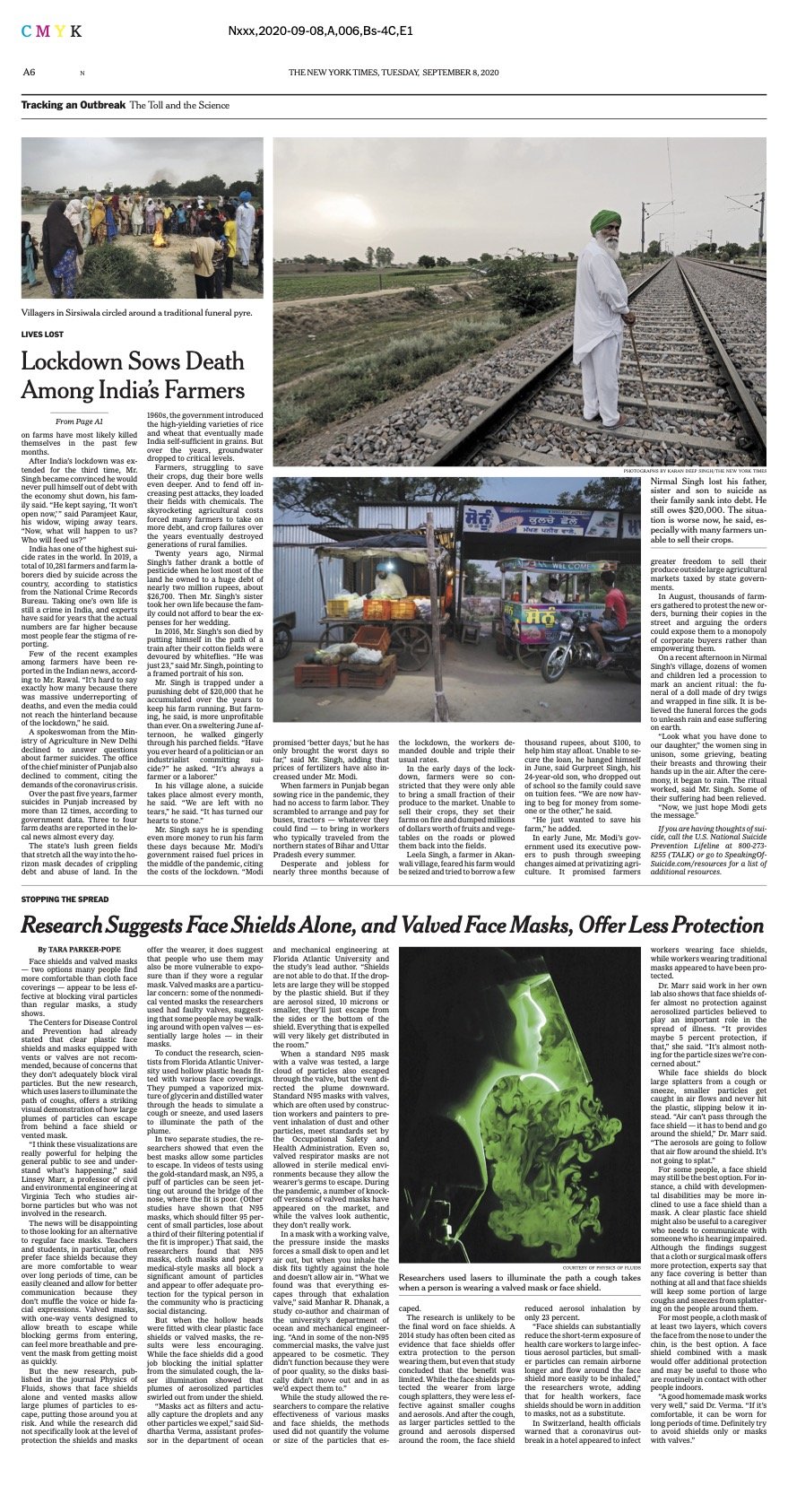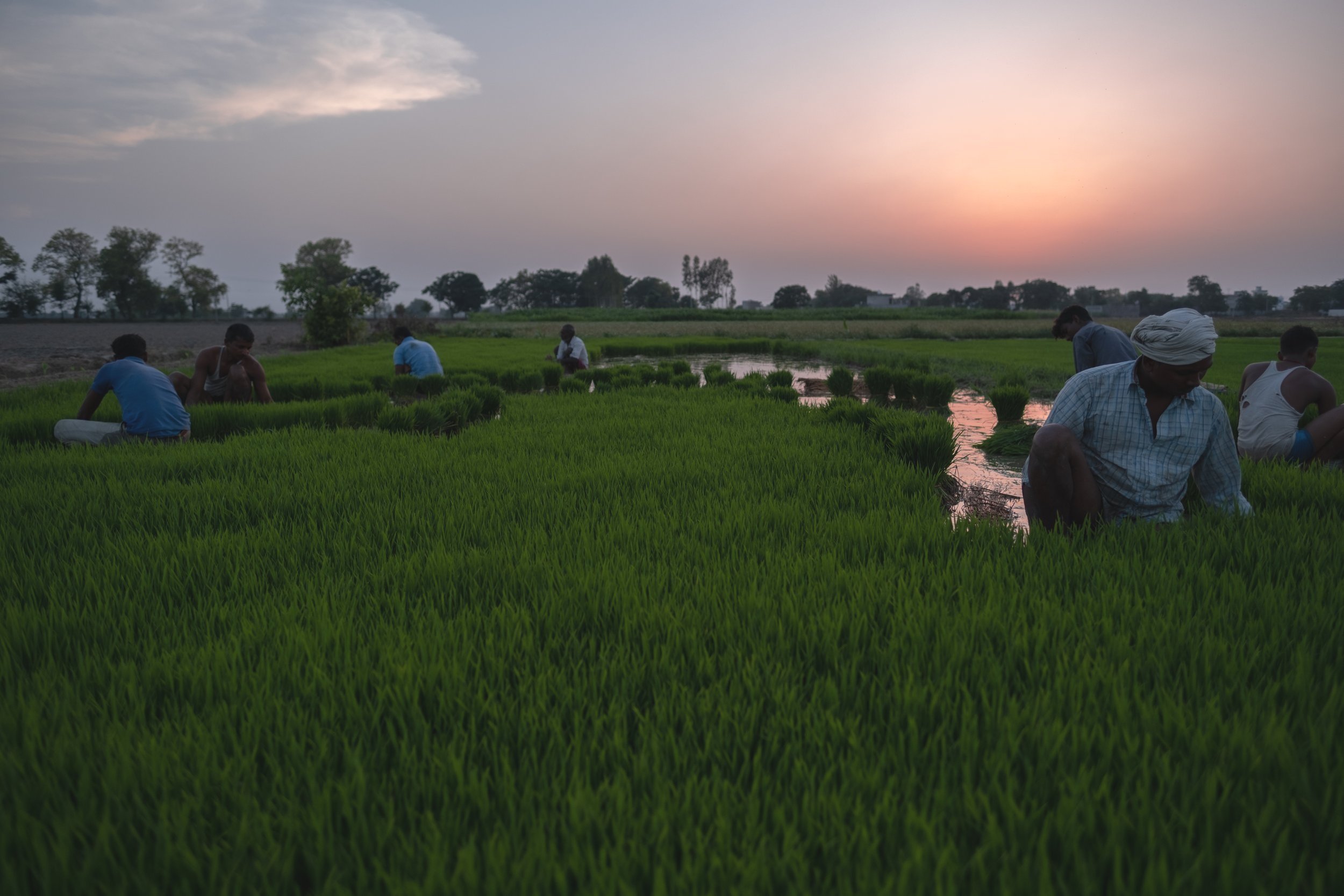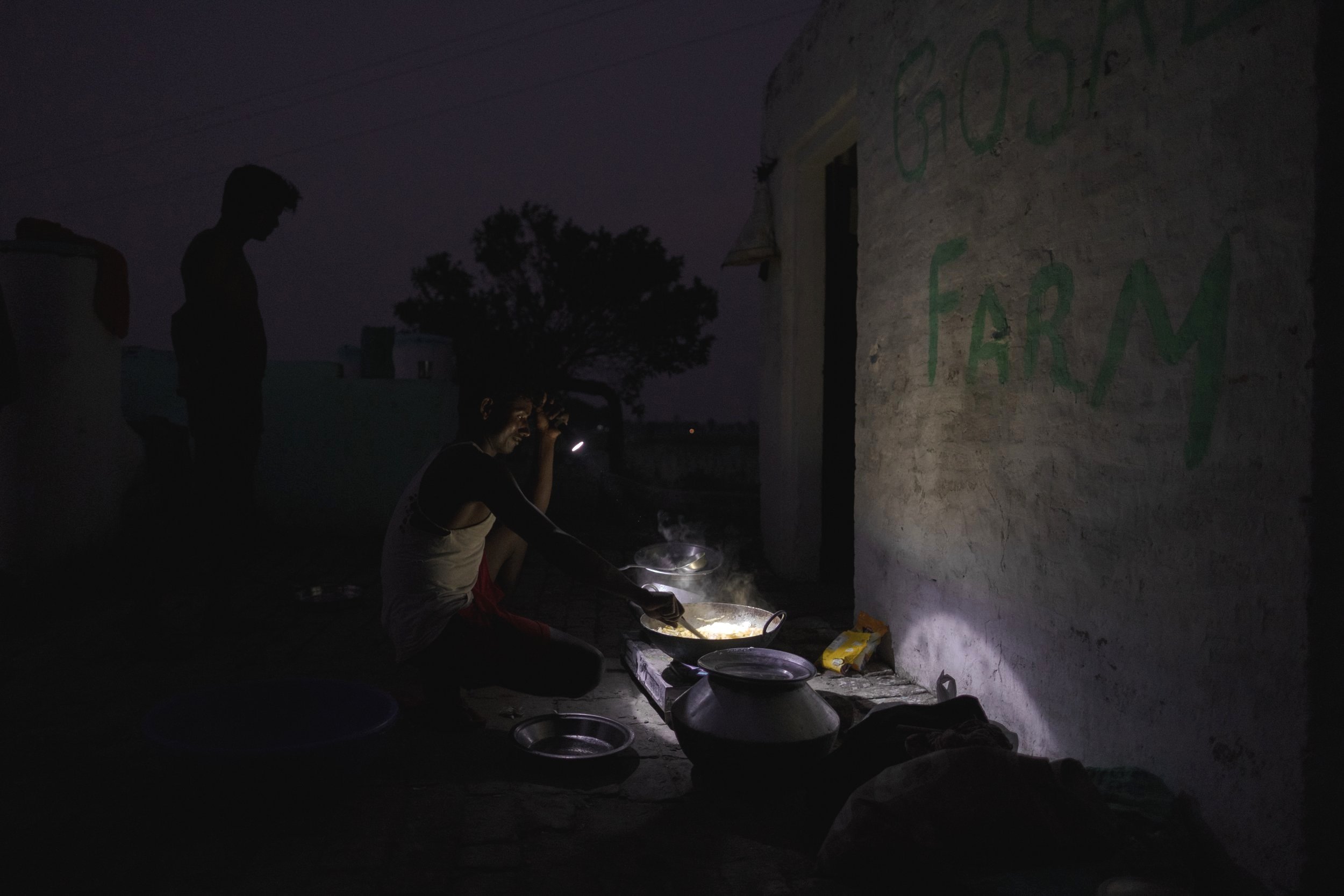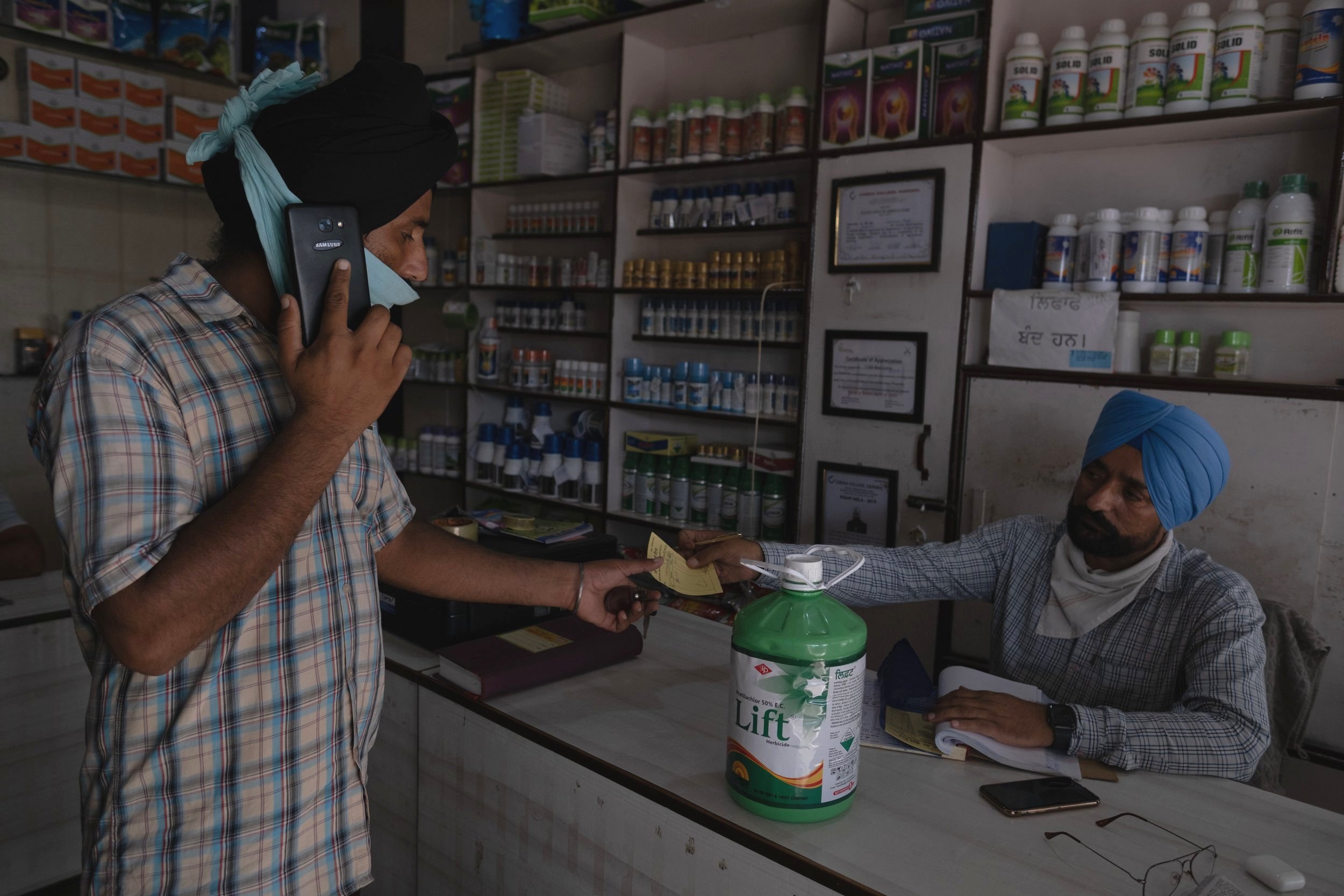‘The Lockdown Killed My Father’: Farmer Suicides Add to India’s Virus Misery
THE NEW YORK TIMES, SEPT 8, 2020
Randhir Singh's widow, Paramjeet Kaur, and son Rashpal Singh at their village home in the northern Indian state of Punjab. Photo: Karan Deep Singh/The New York Times
Farm bankruptcies and debts have been the source of misery in India for decades. But experts say the suffering has reached new levels in the pandemic.
BY KARAN DEEP SINGH
SIRSIWALA, India — Randhir Singh was already deeply in debt when the coronavirus pandemic struck. Looking out at his paltry cotton field by the side of a railway track, he walked in circles, hopeless. In early May, he killed himself by lying on the same track.
“This is what we feared,” said Rashpal Singh, Mr. Singh’s 22-year-old son, choking back tears in his family home in Sirsiwala, a small village in the northern Indian state of Punjab. “The lockdown killed my father.”
Months ago, when Prime Minister Narendra Modi imposed one of the world’s strictest lockdowns to prevent the spread of the coronavirus, Mr. Singh’s livelihood came crashing down. His one-acre farm had barely produced enough cotton to cover the cost of growing it, and the lockdown even robbed him of his side job as a bus driver.
India now leads the world in new daily reported coronavirus cases and has the second-highest number of cases globally, surpassing Brazil on Monday. In Punjab, where cases have surged, lockdowns have been imposed all over again. The measures, economists say, are forcing millions of households into poverty and contributing to a long-running tragedy: farmer suicides.
Farm bankruptcies and debts like the one that tormented Mr. Singh have been the source of misery in the country for decades, but experts say the suffering has reached new levels in the pandemic.
“This crisis is the making of this government,” said Vikas Rawal, a professor of economics at the Jawaharlal Nehru University in New Delhi, the capital. Mr. Rawal, who has spent the last 25 years studying agrarian distress in India, said that he believes thousands of people who live and work on farms have most likely killed themselves in the last few months.
Farmers in Punjab have seen their savings dwindle as they have invested heavily to cultivate rice. Photo: Karan Deep Singh/The New York Times
Farm workers tending to rice paddies in Goslan, India. Desperate for money after months of lockdown, some farm laborers have been demanding as much as three times the typical wage. Photo: Karan Deep Singh/The New York Times
After India’s lockdown was extended for the third time, Mr. Singh became convinced he would never pull himself out of debt with the economy shut down, his family said. “He kept saying, ‘It won’t open now,’” said Paramjeet Kaur, his widow, wiping away tears. “Now, what will happen to us? Who will feed us?”
India has one of the highest suicide rates in the world. In 2019, a total of 10,281 farmers and farm laborers died by suicide across the country, according to statistics from the National Crime Records Bureau. Taking one’s own life is still a crime in India, and experts have said for years that the actual numbers are far higher because most people fear the stigma of reporting.
Few of the recent examples among farmers have been reported in the Indian news media, according to Mr. Rawal. “It’s hard to say exactly how many because there was massive underreporting of deaths, and even the media could not reach the hinterland because of the lockdown,” he said.
A spokeswoman from the Ministry of Agriculture in New Delhi declined to answer questions about farmer suicides. The office of the chief minister of Punjab also declined to comment, citing the demands of the coronavirus crisis.
Every season, migrant workers from the northern states of Uttar Pradesh and Bihar travel hundreds of miles to work at the world’s largest grain market in Khanna, India. Photo: Karan Deep Singh/The New York Times
Sacks of shelled corn at the market in Khanna. Photo: Karan Deep Singh/The New York Times
Over the last five years, farmer suicides in Punjab increased by more than 12 times, according to government data. Three to four farm deaths are reported in the local news almost every day.
The state’s lush green fields that stretch all the way into the horizon mask decades of crippling debt and abuse of land. In the 1960s, the government introduced the high-yielding varieties of rice and wheat that eventually made India self-sufficient in grains. But over the years, groundwater dropped to critical levels.
Farmers, struggling to save their crops, dug their bore wells even deeper. And to fend off increasing pest attacks, they loaded their fields with chemicals. The skyrocketing agricultural costs forced many farmers to take on more debt, and crop failures over the years eventually destroyed generations of rural families.
Twenty years ago, Nirmal Singh’s father drank a bottle of pesticide when he lost most of the land he owned to a huge debt of nearly two million rupees, about $26,700. Then Mr. Singh’s sister took her own life because the family could not afford to bear the expenses for her wedding.
In 2016, Mr. Singh’s son died by putting himself in the path of a train after their cotton fields were devoured by whiteflies. “He was just 23,” said Mr. Singh, pointing to a framed portrait of his son.
Migrant workers from Hardoi, India, rode on the back of a tractor full of paddy stalks. Photo: Karan Deep Singh/The New York Times
Bijay Kumar, a worker from Bihar, used a flashlight to prepare a meal of potato curry and rice. Photo: Karan Deep Singh/The New York Times
Mr. Singh is trapped under a punishing debt of $20,000 that he accumulated over the years to keep his farm running. But farming, he said, is more unprofitable than ever. On a sweltering June afternoon, he walked gingerly through his parched fields. “Have you ever heard of a politician or an industrialist committing suicide?” he asked. “It’s always a farmer or a laborer.”
In his village alone, a suicide takes place almost every month, he said. “We are left with no tears,” he said. “It has turned our hearts to stone.”
Mr. Singh says he is spending even more money to run his farm these days because Mr. Modi’s government raised fuel prices in the middle of the pandemic, citing the costs of the lockdown. “Modi promised ‘better days,’ but he has only brought the worst days so far,” said Mr. Singh, adding that fertilizers and pesticides prices have also increased under Mr. Modi.
“The lockdowns have destroyed us,” said Nirmal Singh, a farmer. “Every month someone commits suicide here.” Photo: Karan Deep Singh/The New York Times
A young man praying in Goslan. Scarred by death and misery, a young generation of Punjabis is looking to leave rural life behind in the hope for a better future. Photo: Karan Deep Singh/The New York Times
When farmers in Punjab began sowing rice in the pandemic, they had no access to farm labor. They scrambled to arrange and pay for buses, tractors — whatever they could find — to bring in workers who typically traveled from the northern states of Bihar and Uttar Pradesh every summer.
Desperate and jobless for nearly three months because of the lockdown, the workers demanded double and triple their usual rates.
In the early days of the lockdown, farmers were so constricted that they were only able to bring a small fraction of their produce to the market. Unable to sell their crops, they set their farms on fire and dumped millions of dollars worth of fruits and vegetables on the roads or plowed them back into the fields.
Leela Singh, a farmer in Akanwali village, feared his farm would be seized and tried to borrow a few thousand rupees, about $100, to help him stay afloat. Unable to secure the loan, he hanged himself in June, said Gurpreet Singh, his 24-year-old son, who dropped out of school so the family could save on tuition fees. “We are now having to beg for money from someone or the other,” he said.
“He just wanted to save his farm,” he added.
The pandemic and its economic disruption have put millions of Indians out of work. Photo: Karan Deep Singh/The New York Times
Farmers are turning to chemicals to save their crops, said Gurcharan Singh, who runs a pesticide store in Khamanon, India. Photo: Karan Deep Singh/The New York Times
In early June, Mr. Modi’s government used its executive powers to push through sweeping changes aimed at privatizing agriculture. It promised farmers greater freedom to sell their produce outside large agricultural markets taxed by state governments.
In August, thousands of farmers gathered to protest the new orders, burning their copies in the street and arguing the orders could expose them to a monopoly of corporate buyers rather than empowering them.
On a recent afternoon in Nirmal Singh’s village, dozens of women and children led a procession to mark an ancient ritual: the funeral of a doll made of dry twigs and wrapped in fine silk. It is believed the funeral forces the gods to unleash rain and ease suffering on earth.
“Look what you have done to our daughter,” the women sing in unison, some grieving, beating their breasts and throwing their hands up in the air. After the ceremony, it began to rain. The ritual worked, said Mr. Singh. Some of their suffering had been relieved.
“Now, we just hope Modi gets the message.”
Women of Sirsiwala gathered for an ancient ritual believed to force the gods to unleash rain and ease suffering. Photo: Karan Deep Singh/The New York Times
READ THIS STORY ON THE NEW YORK TIMES WEBSITE.
If you are having thoughts of suicide, call the U.S. National Suicide Prevention Lifeline at 800-273-8255 (TALK) or go to SpeakingOfSuicide.com/resources for a list of additional resources.
Published on Page 1, Sept 8, 2020, New York edition of The New York Times













